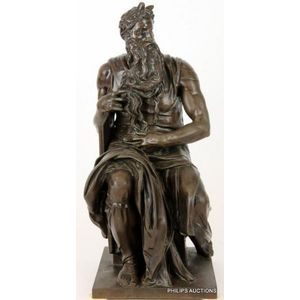Barbedienne's Bronze Moses Holding Tablets of Law
A French bronze figure of the seated Moses by Barbedienne, late 19th century cast by Ferdinand Barbedienne after the original marble by Michelangelo, now in the church of S. Pietro in Vincoli, Rome., the seated figure of Moses holding the tablets of the law under his arm, with mid brown patination, inscribed 'F. Barbedienne, Fondeur' and bearing the Collas reduction seal stamp. Height 37.5 cm
You must be a subscriber, and be logged in to view price and dealer details.
Subscribe Now to view actual auction price for this item
When you subscribe, you have the option of setting the currency in which to display prices to $Au, $US, $NZ or Stg.
This item has been sold, and the description, image and price are for reference purposes only.
- Patination / Patina - In broad terms, patination refers to the exterior surface appearance of the timber, the effect of fading caused by exposure to sunlight and air over the course of a century or more, changing the piece to a soft, mellow colour.
As patina is very difficult to replicate, it is one of the most important guides to determining the age of furniture.
Patina is also the term applied to the bloom or film found on old bronzes due to oxidisation. - "reduction Mecanique A. Collas Brevete" - "Reduction Mecanique A. Collas Brevete" stamped onto a raised disk on a statue translates as "Mechanical Reduction, A. Collas Patent", referring to the patented method used to reduce the sculptures from their original size. Achille Collas (1795?1859) was a French engineer, inventor, writer and engraver who in 1836 developed a pantograph style machine which enabled him to reduce sculptures to a smaller scale. In 1838, he started a company together with Ferdinand Barbedienne, who was experienced in foundry techniques, to produce reduced copies of sculptures in materials including plaster, wood, bronze and ivory. Following the Great Exhibition of 1851 in London where the company received a special medal, and the Exposition Universelle in Paris when Collas was awarded the Grand Médaille d'Honneur the sculptures became increasingly popular and by 1892 had over 600 employees. The company, Société Collas et Barbedienne continued in production until 1954.
- Bronze - An alloy of copper and tin, traditionally in the proportions of about 9 parts of copper to 1 part of tin.
The discovery of bronze in Western Asia in the 4th century enabled people to create metal objects which were superior to those previoulsy possible because of its strength and hardness, and it has been used throughout the world for weapons, coins, tools, statuary and other decorative items.
It is very fluid in a molten state, and its hardness, strength when set, and non-corrosive properties makes it most suitable for casting sculpture.
This item has been included into following indexes:
